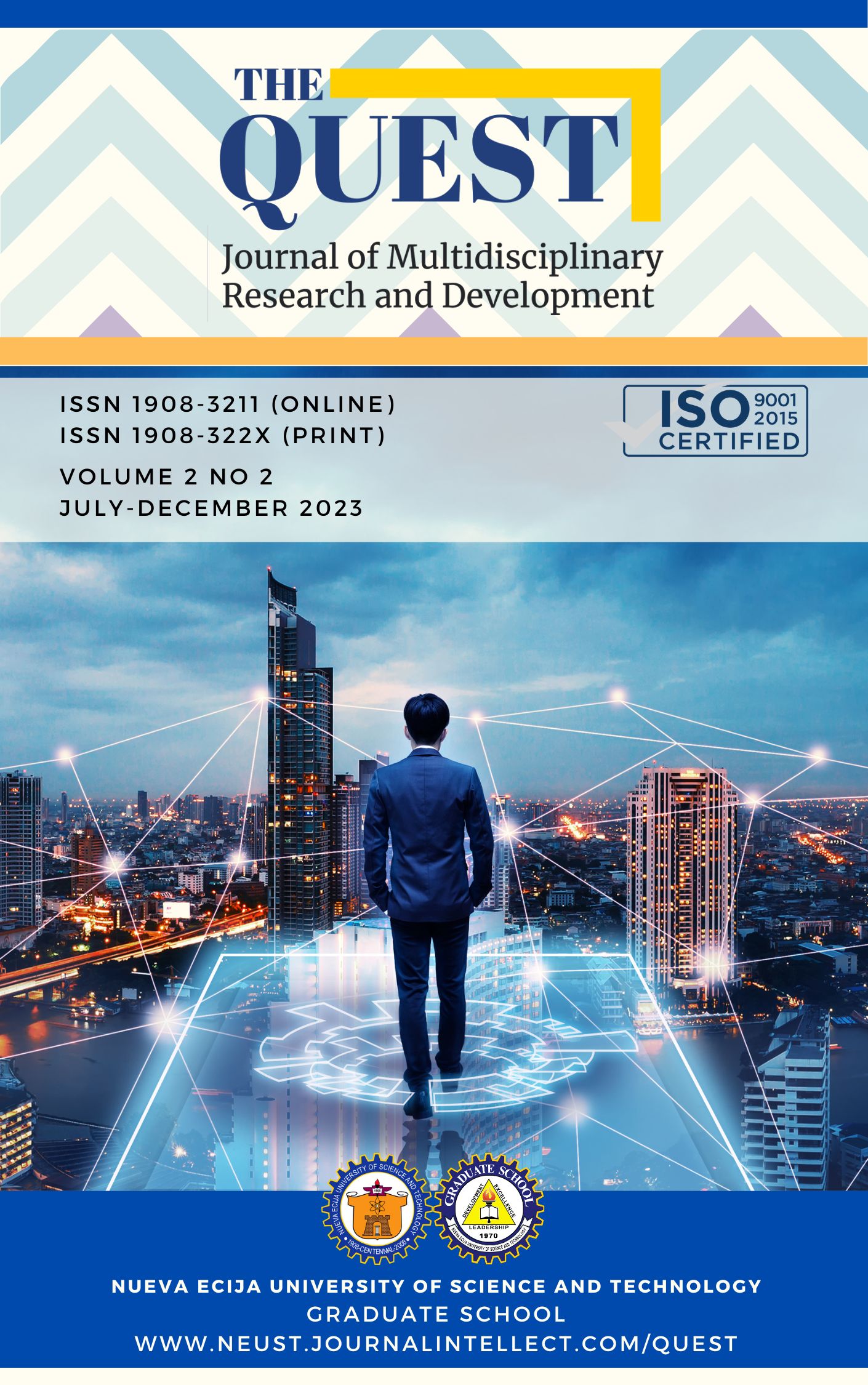Online Teaching Effectiveness of Nurse Instructors: A Systematic Literature Review

Published 12/30/2023
Keywords
- nurse instructors,
- online education,
- online teaching,
- online teaching effectiveness
How to Cite
Copyright (c) 2023 The QUEST: Journal of Multidisciplinary Research and Development

This work is licensed under a Creative Commons Attribution-NonCommercial 4.0 International License.
Abstract
The online teaching effectiveness of nurse instructors builds a systematic literature review that aimed to identify and critically assess available research publications for identifying online teaching effectiveness in nursing education. The review process undergoes five stages namely: framing of questions for review, identifying relevant work, data screening, assessing the quality of studies, and interpretation of findings. The articles were thematically analyzed. The articles' patterns were observed and grouped accordingly. The themes were subsequently aggregated and organized into a thematic map. The thematic map served as the basis for the generation of item statements. The three main themes that emerged based on the thematic analysis of the systematic literature review were: active learning, instructor-learner connection, and modern teaching.
Keywords: Nurse instructors; Online education; Online teaching, Online teaching effectiveness
References
- Allen, I. E., & Seaman, J. (2017). Digital learning compass: Distance education enrollment report 2017. Babson Survey research Group, e-Literature, and WCET. https://eric.ed.gov/?id=ED581926
- Al-Rawajfah, O. M., Al Hadid, L., Madhavanprabhakaran, G. K., Francis, F., & Khalaf, A. (2022). Predictors of effective clinical teaching – nursing educators’ perspective. BMC Nursing, 21(1), 1–9. https://bmcnurs.biomedcentral.com/articles/10.1186/s12912-022-00836-y
- Alvarez, I., Guasch, T., & Espasa, A. (2009). University teacher roles and competencies in online learning environments: A theoretical analysis of teaching and learning practices. European Journal of Teacher Education, 32(3), 321–336.
- Baker, M., Richardson, S., & Rubio, F. (2020). Evaluating Teaching Presence in an Online Nursing Course: Proposing a New Taxonomy. International Journal of E-Learning & Distance Education, 35(2). https://files.eric.ed.gov/fulltext/EJ1299366.pdf
- Baran, E., Correia, A. P., & Thompson, A. (2011). Transforming online teaching practice: critical analysis of the literature on the roles and competencies of online teachers. Distance Education, 32(3), 421-439.
- Chickering, A. W., & Ehrmann, S. C. (1996). Implementing the seven principles: Technology as lever. AAHE Bulletin, 49(2-3), 3-6.
- Chickering, A., & Gamson, Z. (1987). Seven Principles for Good Practice in Undergraduate Education. AAHE Bulletin, 3–7. https://files-eric-ed-gov.dcu.idm.oclc.org/fulltext/ED282491.pdf
- Christoffers, C., Bano, C., & Gorz, M. (2023). Practical Implications of Online Learning with Nurses During Coronavirus Disease 2019. Nursing Clinics of North America, 58(1), 107-119.
- Dakhi, O., Jama, J., & Irfan, D. (2020). Blended learning: a 21st century learning model at college. International Journal of Multi Science, 1(08), 50-65.
- Edwards, M., Perry, B., & Janzen, K. (2011). The making of an exemplary online educator. Distance Education, 32(1), 101–118.
- Frazer, C., Sullivan, D. H., Weatherspoon, D., & Hussey, L. (2017). Faculty Perceptions of Online Teaching Effectiveness and Indicators of Quality. Nursing Research & Practice, 1–6. https://www.hindawi.com/journals/nrp/2017/9374189/
- Johns Hopkins Nursing Evidence-Based Practice (2020). https://hsl.upstate.edu/uploads/20200214-jhneb/2017_Appendix-G_Individual-Evidence-Tool.pdf
- Kraglund-Gauthier, W., & Moseley, J. (2019). Building Teaching-Learning Capacities of Online Nurse Educators: Using TPACK to Frame Pedagogical Processes and Identify Required Supports. Canadian Journal of Learning and Technology, 45(1). https://files.eric.ed.gov/fulltext/EJ1214588.pdf
- Kucuk, S., & Richardson, J. C. (2019). A Structural Equation Model of Predictors of Online Learners’ Engagement and Satisfaction. Online Learning, 23, 196-216. https://olj.onlinelearningconsortium.org/index.php/olj/article/view/1455/824
- Lockwood, C., Munn, Z., & Porritt, K. (2015). Qualitative research synthesis: methodological guidance for systematic reviewers utilizing meta-aggregation. JBI Evidence Implementation, 13(3), 179-187.
- Page, M. J., McKenzie, J. E., Bossuyt, P. M., Boutron, I., Hoffmann, T. C., Mulrow, C. D., & Moher, D. (2021). The PRISMA 2020 statement: an updated guideline for reporting systematic reviews. Systematic Reviews, 10 (89), 1–11.
- Peters, M. A., Jandrić, P., & McLaren, P. (2020). Pandemic education: Global perspectives on emergency remote online learning. Routledge.
- Raja, R., & Nagasubramani, P. C. (2018). Integrating technology in the curriculum: A critical review. Journal of Education and Practice, 9(6), 1-7.
- Seaman, J. E., Allen, I. E., & Seaman, J. (2018). Grade increase: Tracking distance education in the United States. Babson Survey Research Group.
- Shea, B. J., Reeves, B. C., Wells, G., Thuku, M., Hamel, C., Moran, J., ... & Henry, D. A. (2017). AMSTAR 2: a critical appraisal tool for systematic reviews that include randomised or non-randomised studies of healthcare interventions, or both. bmj, 358.
- Stoll, C. R. T., Izadi, S., Fowler, S., Green, P., Suls, J., & Colditz, G. A. (2019). The value of a second reviewer for study selection in systematic reviews. Research synthesis methods, 10(4), 539–545. https://doi.org/10.1002/jrsm.1369
- Sun, A., & Chen, X. (2016). Online education and its effective practice: A research review. Journal of Information Technology Education: Research, 15, 157-190. http://www.informingscience.org/Publications/3502
- Williams, P. E. (2003). Roles and Competencies for Distance Education Programs in Higher Education Institutions. American Journal of Distance Education, 17(1), 45–57.
